Medical schools certainly need microscopes, anatomy books, and cadaver labs. But some experts believe they also need moveable walls, chairs that swivel, and sunny gathering spots.
As medical schools plan new facilities or renovate old ones, they are considering the many ways brick-and-mortar structures can promote pedagogical excellence. Using cutting-edge architecture and technological best practices, they are creating physical spaces that advance such educational goals as active learning, teamwork, and interdisciplinary collaboration.
“Design is a dynamic, exciting way to enhance the learning experience,” says Lisa Howley, AAMC senior director of strategic initiatives and partnerships in medical education. “Of course, we don’t need to be limited by physical structure as we find new, engaging ways to teach, but thinking about the physical environment can be a powerful way to advance experiential learning.”
Here are how three innovative institutions are using their buildings to meet the needs of today’s students and to promote the care of tomorrow’s patients.
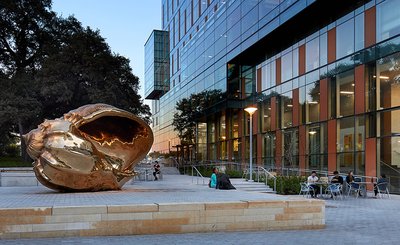 Dror Baldinger, AIA
Dror Baldinger, AIA
When Dell Medical School at The University of Texas at Austin (UT Austin) opened its doors in 2016, standard classrooms with desks in rows were gone. So were huge lecture halls where all eyes focus on an instructor at a lectern.
Instead, physical spaces were designed around the school’s motto, “rethink everything,” explains Lawrence Speck, a UT Austin School of Architecture professor who helped design the facility.
Speck cites Winston Churchill’s quote, “We shape our buildings, and afterwards, our buildings shape us,” to underscore the impact physical design can have on curricular goals.
 Dror Baldinger, AIA
Dror Baldinger, AIA
Among the design features meant to promote collaboration and innovation at Dell Medical School are 10 small-group study rooms that are open 24/7, where students can write on glass walls. There’s also a lab that combines access to human cadavers with sophisticated audio-visual technology. And classrooms use swivel chairs instead of fixed chairs facing the front of the room so students can interact more easily with one another.
To further its goal of enhancing inter-professional education, the medical school contributed to renovating the UT Austin School of Nursing and the two now share spaces. In addition, students and faculty from various disciplines, including pharmacy, biomedical engineering, and kinesiology and health education, meet in the school’s Team-Based Learning Center each week.
 Dror Baldinger, AIA
Dror Baldinger, AIA
One of the medical school’s more compelling features is the five-story Health Learning Building, where students and faculty frequently encounter each other in wide, open halls and stairways. “This helps create a larger sense of community,” Speck notes. On the way to his fifth-floor office, for example, the medical school dean often interacts with students.
The key to successful integration of a building’s form with educational function, Speck found, was a strong collaboration between medical school personnel and architects. “We had a lot of back and forth, and it felt like a real team,” he says. “It’s all about customizing architecture and design for the institution’s pedagogical needs.”
At The Robert Larner, M.D. College of Medicine at The University of Vermont, a significant educational focus is on flipped learning. In that model, students study content usually covered in lectures on their own and instead use class time to apply what they learned and work with peers.
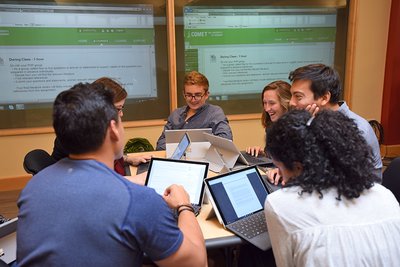 David Seaver
David Seaver
To facilitate this and other academic goals, Larner College of Medicine renovated classrooms, the library, and other spaces. Because students needed to use the buildings during construction, the renovations were rolled out in two phases, one in 2014 and one in 2017, with more work ahead.
“We took existing space and repurposed it,” says William Jeffries, PhD, the school’s senior associate dean for medical education. “We’re converting all our passive learning spaces and eliminating lectures. We put [lecture materials] in the cloud and broke into teams where students learn based on information they bring to class, then problem-solve in class.”
In place of tiered lecture halls, Jeffries explains, “we developed flat-floor spaces where students face one another and work in groups supervised by faculty.”
Medical school administration also reconfigured the existing library space to support such goals as peer-teaching and greater use of digital tools. “Most information now is technologically available,” says Jeffries. “Students rely less on paper journals and books, so we moved much of the [book] collection off-site.”
To encourage greater student collaboration, some spaces use smaller-than-average tables at which students usually share one device rather than using individual laptops or tablets. “We [want students] close enough so they’ll collaborate and so everyone is heard because we want to keep everyone engaged,” Jeffries adds. “They’re peer teaching in proximity to each other. Students like it better, and it fosters active learning.”
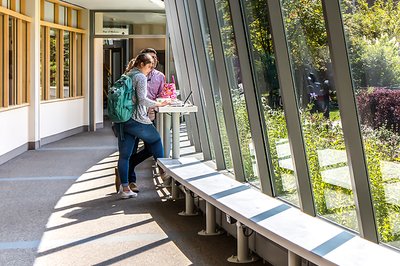 Mark Bayer Photography
Mark Bayer Photography
The redesign included other innovative spaces, from private one-person learning stations to a large hallway used for relaxing, socializing, and learning. “We captured an outside hallway … and added seating and a long bench with good internet access and charging stations. Students can work on their laptops and look out a beautiful window with great natural light,” Jeffries says. “It has become another gathering area where students can meet and work together.”
Renovations focused on faculty needs as well. The library redesign included a Teaching Academy that supports educator development, collaboration, and scholarship. And educators who want help integrating high-tech tools—such as touchable, high-definition screens—into their courses can turn to the co-located Educational Technology Studio, where staff are readily available to help them experiment and innovate.
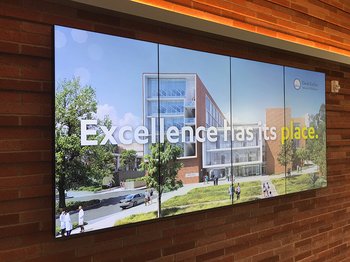 David Geffen School of Medicine at UCLA
David Geffen School of Medicine at UCLA
At the David Geffen School of Medicine at UCLA, faculty and architects focused on creating flexible, high-tech spaces that foster interactive learning when they built Geffen Hall, which opened in January 2017.
“This was the model to prepare the next generation of physicians,” says Zaldy Tan, MD, assistant dean for curricular affairs and a member of the team that planned the building.
Geffen’s Teaching Lab accommodates 180 students in groups of seven or eight at pods throughout the room. Each pod is equipped with locally controlled speakers, so students can join larger discussions or shut down sound for quieter conversations.
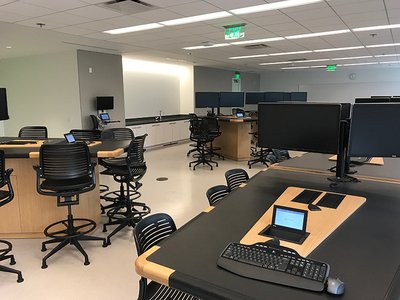 David Geffen School of Medicine at UCLA
David Geffen School of Medicine at UCLA
In addition, the room offers microphones encased in soft boxes that can be tossed from student to student or pod to pod to promote interaction and discussion. Faculty and students can also share information from their individual computers on large wall monitors. What’s more, the lab was built for flexibility: It can be used as one large space or divided into smaller sections thanks to a moveable wall.
The school’s Learning Studio, on the other hand, is “somewhere between a traditional classroom and the Teaching Lab,” Tan notes. The studio has a traditional lectern at the front, but an instructor can walk around “with an iPad and draw a circle or arrow to show something on an X-ray or CAT scan, for example,” and the illustration will appear on screens around the room.
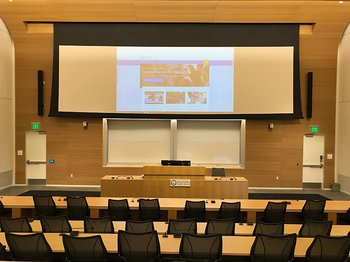 David Geffen School of Medicine at UCLA
David Geffen School of Medicine at UCLA
Geffen Hall’s new designs integrate the latest technology because “today technology is so tied to teaching,” says Tan. “This generation of students will never learn well by just listening to lectures. They learn through technology and participation.”
“As educators, we really need to be involved in the design of learning spaces because physical space and technology have to make sense from a pedagogical standpoint,” he adds. “Does the curriculum inform the educational space or does the educational space inform the curriculum? I think it goes both ways.”